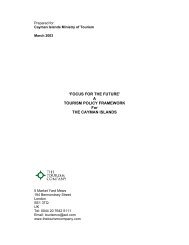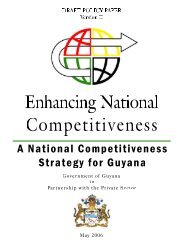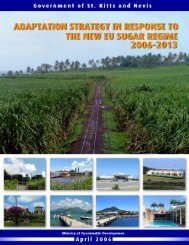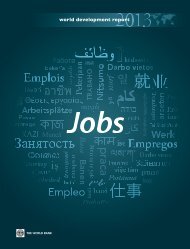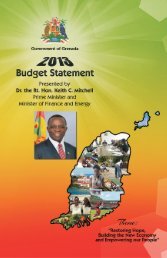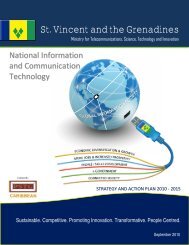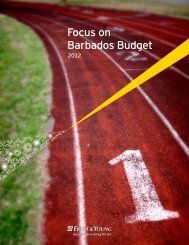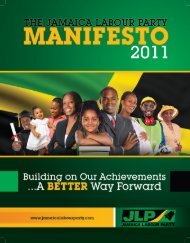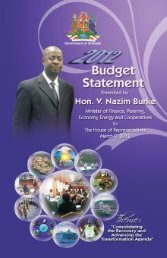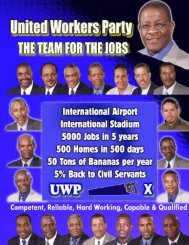Business Removing
Doing Business in 2005 -- Removing Obstacles to Growth
Doing Business in 2005 -- Removing Obstacles to Growth
- No tags were found...
You also want an ePaper? Increase the reach of your titles
YUMPU automatically turns print PDFs into web optimized ePapers that Google loves.
68 DOING BUSINESS IN 2005<br />
tion and the even simpler foreclosure procedure. They<br />
don’t use the fancy reorganization procedure either.<br />
In developing countries, business exit works best in<br />
direct negotiations between the creditor and debtor. In<br />
Ethiopia, Jamaica, Namibia and Thailand, secured creditors<br />
can seize the assets of defaulted companies without<br />
the complex court procedures associated with bankruptcy.<br />
As a result, they can recover 50 cents for every<br />
dollar loaned. 4 Contrast this with 15 cents on the dollar<br />
for liquidation and reorganization bankruptcy proceedings<br />
in other poor countries.<br />
Several countries got reforms right. In 2003, Bulgaria,<br />
Estonia, India, Lithuania, Poland, Romania, Spain,<br />
Tunisia, and the United Kingdom streamlined their<br />
bankruptcy procedures—and some achieved immediate<br />
results. In Bulgaria, the creditors now typically collect 34<br />
cents on a dollar. In Estonia, 40 cents. In Tunisia, 50<br />
cents. In India, where the reform has just started, creditors<br />
now collect 13 cents on the dollar, a third more than<br />
they did a year ago. The reforms share similar features.<br />
They reduce appeals that suspend the bankruptcy<br />
process. They introduce or tighten time limits of procedures.<br />
They establish specialization in dealing with bankruptcy<br />
cases. And they set incentives for the administrator<br />
to get the most from the estate.<br />
Where is exit easy?<br />
When a business closes, creditors and other claimants in<br />
Finland, Japan, Singapore and Taiwan (China) typically<br />
recover 90 cents on the dollar. In Belgium, Canada, Ireland,<br />
the Netherlands, Norway and the United Kingdom,<br />
more than 85 cents on the dollar. These are the 10 economies<br />
with most efficient foreclosure or bankruptcy procedures.<br />
Surveys of business executives agree (figure 9.2).<br />
How do these economies do it? Through a combination<br />
of speed, low cost, and continuity of business operations<br />
(box 9.1). It takes less than a year to resolve<br />
foreclosure or bankruptcy. 5 The cost of closing a business<br />
is just a small percentage of the value of the troubled<br />
business: 1% in Finland, the Netherlands, Norway,<br />
and Singapore; and about 4% in Belgium, Canada, Japan,<br />
and Latvia. And in all of the most efficient ten, the<br />
business is sold or reorganized as a going concern and<br />
management is replaced. 6 No value is lost by stopping<br />
operations. 7<br />
Getting that efficient takes time. Consider Finland, a<br />
leader. It adopted the first bankruptcy law in 1734, when<br />
it was still part of Sweden. More than a century passed<br />
before the law was amended in 1868, now in independent<br />
Finland, to clarify the priority of claims in liquidation.<br />
Another century passed without reforms. In 1970,<br />
the law was reformed to give the bankruptcy administrator<br />
the right to terminate labor contracts on a short<br />
notice. Then in 1978, a new regulation was adopted on<br />
group dismissals in large companies undergoing bankruptcy.<br />
A 1986 amendment enhanced the priority of<br />
floating charge holders. In 1991, the rules for recovery<br />
were elaborated in a separate legislative act. Several other<br />
reforms followed, prompted by the economic stagnation<br />
after the collapse of the Soviet Union—Finland’s most<br />
FIGURE 9.2<br />
Higher recovery rate leads to more usage<br />
Perceived usefulness of bankruptcy law<br />
MORE<br />
USAGE<br />
AVERAGE<br />
RECOVERY<br />
RATE<br />
8 21 32 50 82<br />
Countries ranked by recovery rate, quintiles<br />
Note: Relationships are significant at the 1% level.<br />
Source: Doing <strong>Business</strong> database, WEF (2004).<br />
important trading partner. In 1992, unsecured creditors<br />
were given priority over tax and labor claims. In 1993<br />
a reorganization procedure was introduced. In 1995, a<br />
bankruptcy ombudsman was established to supervise the<br />
administration of bankruptcy estates. Finally in 2004,<br />
an amendment was adopted to prevent frivolous bankruptcy<br />
filings.<br />
Several other countries provide claimants with a<br />
high return when a business closes. In Australia, Austria,<br />
Hong Kong (China), Korea, Latvia, New Zealand, Spain<br />
and Sweden, recovery rates are more than 70 cents. Rich<br />
countries can afford to have a spectrum of exit options—<br />
from foreclosure, which is still the prevalent exit mechanism<br />
in Australia and the United Kingdom, to liquidation,<br />
most often used in Austria, Denmark, Germany, the<br />
Netherlands and Sweden, to reorganization, much used<br />
in Canada, France and the United States. Recent reform<br />
has focused on providing different bankruptcy tracks for<br />
different types of businesses. For example, Finland and



